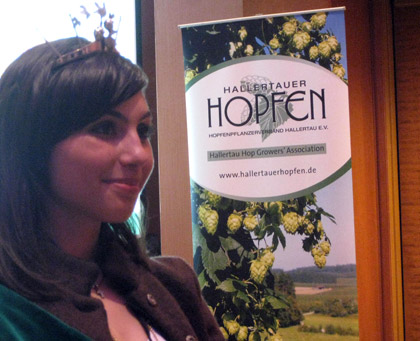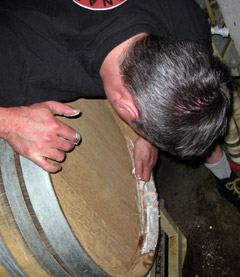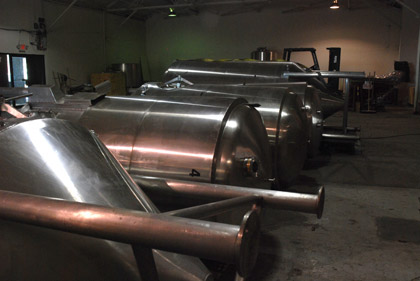
Last Wednesday, just hours after arriving in Chicago for the Craft Brewers Conference, I dutifully posted a photo of Halltertau hop queen Mona Euringer, linked it to via Twitter and Facebook and after that pretty much went back to 1998 or some other CBC in a different technological era. Blog? Tweet? I didn’t even attend the seminars on social media. Sorry.
I did use Google maps on my phone when those of us on the “bus from hell” finally seized control after an obviously clueless bus driver drove around in circles for more than an hour and a half before delivering us to a destination less than 5 miles from the hotel. As an aside, I was on the bus that got lost (not quite an hour extra that time) at the 2008 Craft Brewers Conference. Charles and Rose Ann Finkel were on also on both buses. The takeaway? Never get on the same bus with the Finkels and I at CBC.
This wasn’t exactly planned. I expected to blog and tweet a little more. And it didn’t happen because wi-fi in the host hotel was fleeting and cell reception in the trade show worse yet (both true). Or because there was a rather high level of social activity each evening (obviously true). It’s just that I don’t transition well from information collection mode to dispersal mode. And when I wasn’t at a seminar (like “Proper Storage, Shipping & Handling of Hop Pellets”) there was a conversation awaiting. I particularly like CBC in the even years because of the World Beer Cup competition — judges from 27 countries attended this year.
I’ll be years (yes, really, another book project, details soon) writing about what I learned, so for now here’s one overarching observation from the conference, after the promised report from my conversation with the hop queen and the truth about Bavarian-style pale ale.
Euringer, who turned 23 during the conference, still works on the family farm (hops, corn, and sugar beets — about 38 acres of hops) but also is studying business in school. Her great grandfather was the first in the family to grow hops, but her father has told her that she and her brother, Simon, are free to pursue whatever careers they want.
Since Todd asked . . . Euringer, who began drinking beer when she was 16, likes the fruity flavors hops add to beer. She’s serious. She put in five hours each day at the trade show, often refreshing her glass with one of the five beers showcasing Halltertau hops that Victory Brewing made for the conference. “I can’t drink so much bitter beer,” she said.
I asked her about Schönramer Pils, a 40-plus IBU beer that won gold at European Beer Star Awards last fall. “I like it because of what it tastes like,” she said. “But I can’t drink five bottles of it.”
The day before the conference began she visited New Glarus Brewing in Wisconsin with the rest of the Halltertau hops contingent, and particularly enjoyed the new Two Women pale lager.
Since Ron asked . . . The “Bavarian-style pale ale” created for the conference is a beer description, not a new style. A little confusing because for logistical purposes what we tasted was brewed in Pennsylvania, but it is Bavarian, pale and an ale, fermented with Weihenstephan #68, a top-fermenting yeast otherwise used to create weiss beers.
The grist is 100% pale Franconian barley malt, and it was mashed (single-decoction) for a high attenuation. It was hopped with Hallertauer Mittelfrüh, Hersbrucker, Tradition, Select, and Smaragd in five separate additions. The starting gravity was 16 ºP, the final abv 7.2% and the IBU about 45.
Now the observation, which is not exactly new, given that “microbrews” have been with us a while and these days the CBC seems awfully grown up (most of the sessions I attended focused on making beer, but options included “Craft Brand and SKU Proliferation: Great Opportunity of Great Danger” and “Intellectual Property law: Options and Protections for the Brewing Industry”):
Sales wouldn’t still be growing if somebody didn’t want to drink all these beers. But the beers wouldn’t exist at all if people (we call them brewers) weren’t excited about what they make and how their work is received.
Part One. Beer and food. I’m with Alan when he writes about the “need to ‘pair’ beer with food.” But shortly before the Gala Awards Dinner (for the World Beer Cup) on Saturday I spent a few minutes with Randy Mosher and Sean Paxton, who together created the menu that Sean then executed.
Sean’s attention to detail and creativity defy description (hop scented hard boiled eggs in the salad, just amazing). But, as Randy pointed out, the meal stuck to the notion that beer shouldn’t be fussy, and therefore beer meals shouldn’t be either.
Two evenings before Goose Island treated conference attendees to an equally amazing food experience, inviting more than a dozen Chicago chefs to create special dishes that were served with a couple of dozen of Goose Island beers. There were also a dozen variations on Bourbon County Stout served with a dozen chocolate desserts. All in the midst of about 1,000 barrels.
My point would be that this food and beer thing excites brewers, just like Part Two.
 Part Two. Beers aged in barrels, sour and otherwise. Attendees filled the chairs, lined up along all the walls and took seats in the aisles for Vinnie Cilurzo’s talk called “Toothpicks, Garlic and Chalk: Three Key Ingredients to Any Brewery’s Barrel-Aged Sour Beer Program.” (In the photo on the right Cilurzo is using those tools to plug a leaking barrel at the Russian River brewpub.)
Part Two. Beers aged in barrels, sour and otherwise. Attendees filled the chairs, lined up along all the walls and took seats in the aisles for Vinnie Cilurzo’s talk called “Toothpicks, Garlic and Chalk: Three Key Ingredients to Any Brewery’s Barrel-Aged Sour Beer Program.” (In the photo on the right Cilurzo is using those tools to plug a leaking barrel at the Russian River brewpub.)
It seemed like half those in the room raised their hands when he asked if they’d like to attend a pre-conference seminar next year (when CBC in in San Francisco) on barrel-aged sour beers. These beers intrigue brewers. They want to make them, and sometimes that’s all that matters.
Again, not exactly new territory, but Friday afternoon I was reminded about the traits shared by people who make beer and people who drink beer when Mike Kallenberger of MillerCoors was talking rather specifically about craft beer drinkers (“What’s important to them when they’re not drinking beer, and why it matters when they are”).
Summarizing Kallenberger is never easy, because he tends to tackle complicated subjects, so I’m going to grab one thread and hope I don’t tangle it. Craft-beer drinkers take risks because they they think they are worth taking, if there’s such a thing as a “responsible rebel” that’s them, and they see themselves as “making their own rules” rather than simply “breaking the rules.”
Because they know they are right.
Didn’t we just describe brewers as well? Recipes-by-focus-group don’t work for them on any level. Not telling them what new, new flavor drinkers will embrace. Certainly what they can’t do, what wouldn’t work, what people wouldn’t drink.
They know better.
Some are wrong. Some will fail. Some will make horrible, unbalanced beer. But I think we can tell the difference.

 Part Two. Beers aged in barrels, sour and otherwise. Attendees filled the chairs, lined up along all the walls and took seats in the aisles for Vinnie Cilurzo’s talk called “Toothpicks, Garlic and Chalk: Three Key Ingredients to Any Brewery’s Barrel-Aged Sour Beer Program.” (In the photo on the right Cilurzo is using those tools to plug a leaking barrel at the Russian River brewpub.)
Part Two. Beers aged in barrels, sour and otherwise. Attendees filled the chairs, lined up along all the walls and took seats in the aisles for Vinnie Cilurzo’s talk called “Toothpicks, Garlic and Chalk: Three Key Ingredients to Any Brewery’s Barrel-Aged Sour Beer Program.” (In the photo on the right Cilurzo is using those tools to plug a leaking barrel at the Russian River brewpub.)
